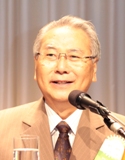Current Situation of Cambodia
September 22, 2010
Mr. Katsuhiro Shinohara,
Deputy Chairperson & Representative of Cambodia Office,
Cambodia International Education Support Foundation
 ��Cambodia is located in the southwest of the Indochina Peninsula. Its land area is about half the size of Japan, yet Cambodia is a rich agricultural country situated at the delta of the Mekong River.
��Cambodia is located in the southwest of the Indochina Peninsula. Its land area is about half the size of Japan, yet Cambodia is a rich agricultural country situated at the delta of the Mekong River.
1. Cambodia before 1970
��Living standards in Cambodia before 1970 were similar to those in neighboring Thailand or Myanmar. Education and military budgets accounted for 24% of the national budget respectively. Teachers were well compensated, which encouraged a talented person to become a teacher. These teachers nurtured individuals who made positive contributions to society.
2. Cambodia after March 1970
��War in Vietnam had repercussions to neutral Cambodia, inflicting conflicts which lasted for 21 years until a peace agreement was signed in 1991.
��Pol Pot regime came to power in 1975 and reigned in a cruel manner. It was so-called ��ultra nationalism��, and an unrelenting purge was conducted.
��City residents were forced to move into the countryside, with further relocation to specific areas there, preventing them from settling down in certain locations. As a result, rural communities were devastated, making local politics extremely difficult for many years to follow,
��The most damaging policy taken by the Pol Pot regime was the total destruction of the long-established structure underlying the nation, especially in the judicial and administrative area. Currencies were abolished, forcing people to resort to a primitive way to barter goods. Long-lasting conflicts also destroyed the basic infrastructure for life.
��As many educated people were killed in the genocide, a shortage among the intellectual classes hampered the reconstruction of Cambodia when peace finally came.
3. Role of Japan in the reconstruction phase
��As the largest donor country, Japan has continued to play a leading role in the reconstruction and rehabilitation phase of Cambodia. Cambodian people are grateful for ��generous assistance�� made by Japan, both through governmental and non-governmental channels.
��In 1998, the remnants of the Pol Pot faction finally succumbed, enabling the long awaited political stability. Since 2000 the combination of political and social stability has attracted high levels of foreign investments into Cambodia.
4. Economic situation in Cambodia
��The 10-year-average economic growth rate soared to 9.3% from 1999 to 2008. Although economic growth slumped in 2009, 4-5% growth is forecast for this year.
��High growth is generated by the garment industry, which accounts for 70% of total exports. Tourism industry follows, attracting 2.4 million tourists per year from around the world to over 600 restored ruins, including the Angkor Wat.
��Major cities, such as Phnom Penh and Siem Reap, are undergoing construction of high-rise buildings. Citizens, with enhanced purchasing power, now shop at supermarkets.
5. Future perspective
��It goes without saying that economic development is crucial in Cambodia. At the same time, integrated cooperation is being promoted among ASEAN nations, and Cambodia aims at lifting tariffs by 2015.
��Cambodia has a geographical advantage as a transit point of distribution in the overall development of five countries along the Mekong River (Cambodia, Myanmar, Thailand, Laos, and Vietnam).
��Before long Cambodia will become a complementary production site for Japanese companies operating in Thailand and Vietnam.
��Resource development of oil and gas is advancing in Cambodia, and oil production will start in 2012. Mineral resources, including bauxite, copper and rare metals, are also promising areas of development.
6. Issues to be addressed
��Extensive network of roads, highways and low-priced energy resources must be further developed.
��Personnel training in all fields is also a pressing matter as Cambodia undergoes economic development.
��Cambodia has its long tradition of being an agricultural country, yet agricultural technologies must be updated.
7. Activities of CIESF (Cambodia International Education Support Foundation)
��The primary activity of CIESF is sending ��Teachers Sans (without) Frontiers�� and educational advisors to Cambodia. Although primary school attendance rate is 93%, only 60% of children complete their 6-year-study, while 40% of children are obliged to leave school and work. CIESF aims to enable all children to complete their primary education.
��The most crucial factor is to improve the educational content and quality of educators. While many Japanese NGOs work on the construction of school buildings, we work on personnel training of teachers who actually teach at these schools.
��We plan to send science and mathematics educators to 18 primary teacher training centers and 7 secondary teacher training centers. Currently, 8 Japanese educators are sent to 2 training centers to train teachers. We selected science and mathematics because these subjects could be taught by using symbols. Science classes aim at introducing experiments using hand-made experiment tools.
����Training program for entrepreneurs�� constitutes the second pillar of CIESF activities. We implement the pilot course of practical business administration called ��COBLAS�� (Consulting Based Learning for ASEAN SMEs). This is because not many Cambodians are willing to try starting their own business. Course students are requested to draft their ��new business plans�� and make entries to the competition next January, which will award the top three teams.
��Our third activity is to ��establish a graduate school of education as well as a department of education.�� We start from training government officials undertaking educational administration at a graduate school. We also plan to establish the department of education at the University of Phnom Penh.
��CIESF also provides ��assistance to agricultural university.�� We are currently constructing a university specializing in agriculture at the granary of Battambang.
The primary objective of CIESF is to train ��Teachers Sans Frontiers.�� While we base our activities in Cambodia, we wish to further spread our circle of assistance to Laos and Myanmar, the neighboring countries in need of personnel training.